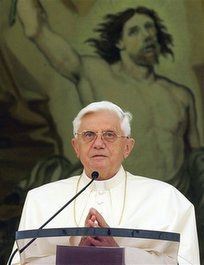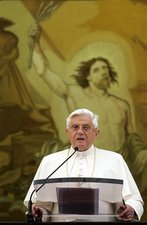Sunday Angelus Message
JMJ+D
 Here is a translation of the words of the Holy Father at the Angelus today in Castel Gandolfo. The first part relating to his Bavarian visit and the Regensburg lecture if the official translation provided by the Vatican Press Office.
Here is a translation of the words of the Holy Father at the Angelus today in Castel Gandolfo. The first part relating to his Bavarian visit and the Regensburg lecture if the official translation provided by the Vatican Press Office.
Dear Brothers and Sisters,
The Pastoral Visit which I recently made to Bavaria was a deep spiritual experience, bringing together personal memories linked to places well known to me and pastoral initiatives towards an effective proclamation of the Gospel for today.
I thank God for the interior joy which he made possible, and I am also grateful to all those who worked hard for the success of this Pastoral Visit. As is the custom, I will speak more of this during next Wednesday’s General Audience.
At this time, I wish also to add that I am deeply sorry for the reactions in some countries to a few passages of my address at the University of Regensburg, which were considered offensive to the sensibility of Muslims. These in fact were a quotation from a medieval text, which do not in any way express my personal thought.
 Yesterday, the Cardinal Secretary of State published a statement in this regard in which he explained the true meaning of my words. I hope that this serves to appease hearts and to clarify the true meaning of my address, which in its totality was and is an invitation to frank and sincere dialogue, with great mutual respect.
Yesterday, the Cardinal Secretary of State published a statement in this regard in which he explained the true meaning of my words. I hope that this serves to appease hearts and to clarify the true meaning of my address, which in its totality was and is an invitation to frank and sincere dialogue, with great mutual respect.
Now, before the Marian prayer, I would like to dwell on two recent and important liturgical commemorations: the Feast of the Exaltation of the Holy Cross, celebrated on September 14, and that of Our Lady of Sorrows, celebrated the day after.
These two liturgical celebrations my be summarized visually in the traditional image of the Crucifixion, which represents the Virgin Mary at the foot of the Cross, according to the description of the Apostle John, the only one of the Apostles who stayed near the dying Jesus.
 But what sense is there to exalt the Cross? Is it not perhaps scandalous to venerate an infamous punishment? The Apostle Paul says: "We preach Jesus crucified - this is scandalous to the Jews, stupid to the pagans." (1 Cor 1,23).
But what sense is there to exalt the Cross? Is it not perhaps scandalous to venerate an infamous punishment? The Apostle Paul says: "We preach Jesus crucified - this is scandalous to the Jews, stupid to the pagans." (1 Cor 1,23).
But Christians do not exalt just any cross, but that Cross which Jesus sanctified with His sacrifice, fruit and testimony of immense love. Christ on the Cross shed all his blood to liberate humanity from the slavery of sin and of death.
Therefore, from being a sign of damnation, the Cross has been transformed into a sign of blessing, from a symbol of death to the symbol par excellence of Love which triumphs over hate and violence and generates immortal life.
"O Crux, ave spes unica! O Cross, the only hope!" - so the liturgy sings.
The evangelist narrates: at the foot of the Cross was Mary (cfr Jn 19, 25-27). Her sorrow is one with that of her Son. It is a sorrow full of faith and love. The Virgin on Calvary participates in the saving power of Christ's pain, uniting her 'fiat' -Thye will be done - with that of Her Son.
Dear brothers and sisters, united spiritually with Our Lady of Sorrows, let us renew our own Yes to God who chose the way of the Cross to save us. This is a great mystery which is ongoing, to the end of the world, and which also requires our participation.
May Mary help us to take up our Cross daily and follow Jesus faithfully along the way of obedience, sacrifice and love.
 Later, he said in English:
Later, he said in English:
I greet all the English-speaking pilgrims and visitors present at today’s Angelus, and I thank you for your prayers during my pastoral visit to Bavaria.
May your stay here in Castel Gandolfo and Rome be a time of spiritual enrichment, marked by the readiness to take up the cross and follow Jesus. Upon you and your loved ones, I invoke the grace and peace of Christ the Lord!
Papa Ratzinger Forum
Images from Papacy and the Vatican
 Here is a translation of the words of the Holy Father at the Angelus today in Castel Gandolfo. The first part relating to his Bavarian visit and the Regensburg lecture if the official translation provided by the Vatican Press Office.
Here is a translation of the words of the Holy Father at the Angelus today in Castel Gandolfo. The first part relating to his Bavarian visit and the Regensburg lecture if the official translation provided by the Vatican Press Office.Dear Brothers and Sisters,
The Pastoral Visit which I recently made to Bavaria was a deep spiritual experience, bringing together personal memories linked to places well known to me and pastoral initiatives towards an effective proclamation of the Gospel for today.
I thank God for the interior joy which he made possible, and I am also grateful to all those who worked hard for the success of this Pastoral Visit. As is the custom, I will speak more of this during next Wednesday’s General Audience.
At this time, I wish also to add that I am deeply sorry for the reactions in some countries to a few passages of my address at the University of Regensburg, which were considered offensive to the sensibility of Muslims. These in fact were a quotation from a medieval text, which do not in any way express my personal thought.
 Yesterday, the Cardinal Secretary of State published a statement in this regard in which he explained the true meaning of my words. I hope that this serves to appease hearts and to clarify the true meaning of my address, which in its totality was and is an invitation to frank and sincere dialogue, with great mutual respect.
Yesterday, the Cardinal Secretary of State published a statement in this regard in which he explained the true meaning of my words. I hope that this serves to appease hearts and to clarify the true meaning of my address, which in its totality was and is an invitation to frank and sincere dialogue, with great mutual respect.Now, before the Marian prayer, I would like to dwell on two recent and important liturgical commemorations: the Feast of the Exaltation of the Holy Cross, celebrated on September 14, and that of Our Lady of Sorrows, celebrated the day after.
These two liturgical celebrations my be summarized visually in the traditional image of the Crucifixion, which represents the Virgin Mary at the foot of the Cross, according to the description of the Apostle John, the only one of the Apostles who stayed near the dying Jesus.
 But what sense is there to exalt the Cross? Is it not perhaps scandalous to venerate an infamous punishment? The Apostle Paul says: "We preach Jesus crucified - this is scandalous to the Jews, stupid to the pagans." (1 Cor 1,23).
But what sense is there to exalt the Cross? Is it not perhaps scandalous to venerate an infamous punishment? The Apostle Paul says: "We preach Jesus crucified - this is scandalous to the Jews, stupid to the pagans." (1 Cor 1,23).But Christians do not exalt just any cross, but that Cross which Jesus sanctified with His sacrifice, fruit and testimony of immense love. Christ on the Cross shed all his blood to liberate humanity from the slavery of sin and of death.
Therefore, from being a sign of damnation, the Cross has been transformed into a sign of blessing, from a symbol of death to the symbol par excellence of Love which triumphs over hate and violence and generates immortal life.
"O Crux, ave spes unica! O Cross, the only hope!" - so the liturgy sings.
The evangelist narrates: at the foot of the Cross was Mary (cfr Jn 19, 25-27). Her sorrow is one with that of her Son. It is a sorrow full of faith and love. The Virgin on Calvary participates in the saving power of Christ's pain, uniting her 'fiat' -Thye will be done - with that of Her Son.
Dear brothers and sisters, united spiritually with Our Lady of Sorrows, let us renew our own Yes to God who chose the way of the Cross to save us. This is a great mystery which is ongoing, to the end of the world, and which also requires our participation.
May Mary help us to take up our Cross daily and follow Jesus faithfully along the way of obedience, sacrifice and love.
 Later, he said in English:
Later, he said in English:I greet all the English-speaking pilgrims and visitors present at today’s Angelus, and I thank you for your prayers during my pastoral visit to Bavaria.
May your stay here in Castel Gandolfo and Rome be a time of spiritual enrichment, marked by the readiness to take up the cross and follow Jesus. Upon you and your loved ones, I invoke the grace and peace of Christ the Lord!
Papa Ratzinger Forum
Images from Papacy and the Vatican


0 Comments:
Post a Comment
<< Home